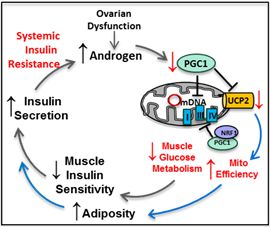Mechanisms of Skeletal Muscle Insulin Resistance in Polycystic Ovary Syndrome
Description. A new area of research in the lab is investigating the effects of hyperandrogenemia with or without obesity on juvenile (pre-pubertal) female neuro-endocrine axis. Polycystic ovary syndrome (PCOS) is one of the most common endocrine disorders in premenopausal women, and is linked to reduced fertility, increased adiposity and an increased risk of developing cardio-metabolic diseases. Insulin resistance (IR) is thought to be a primary contributor to the hormonal pathogenesis of hyperandrogenemia (HA; a defining symptom of PCOS) and the underlying cause of central neuroendocrine dysfunction leading to reduced fertility. Women and adolescent girls with HA develop more severe insulin resistance than BMI-matched controls with normal androgen levels. The cellular signals that initiate the development of IR with PCOS are not known. Therefore, the overall goal of this pilot proposal is to investigate the cellular pathways that initiate skeletal muscle IR with HA in lean and obese adolescent females using an established rhesus macaque model of PCOS.

This work is part of the NIH NCTRI at Oregon National Primate Research Center.
Tools & Skills. This work does not require handling of live animals. All tissue is collected by the pathologists or veterinarian during necropsy at ONPRC. Muscle samples are then process for the following types of studies.
- Mitochondrial respiration and substrate metabolism in fresh isolated fiber bundles
- Skeletal muscle fiber dissection
- High resolution respirometry
- Substrate metabolism
- Primary muscle cell isolation & cell sorting by FACS
- Isolation of primary myoblasts for investigation/manipulation of cellular signaling pathways
- Cell culture techniques & experiments
- Gene knockdown by siRNA
- Signaling pathway analysis by immunoblotting, immunoprecipitation, ChIP
- Gene expression by qPCR
- Insulin stimulated glucose uptake
- Metabolomics Analysis